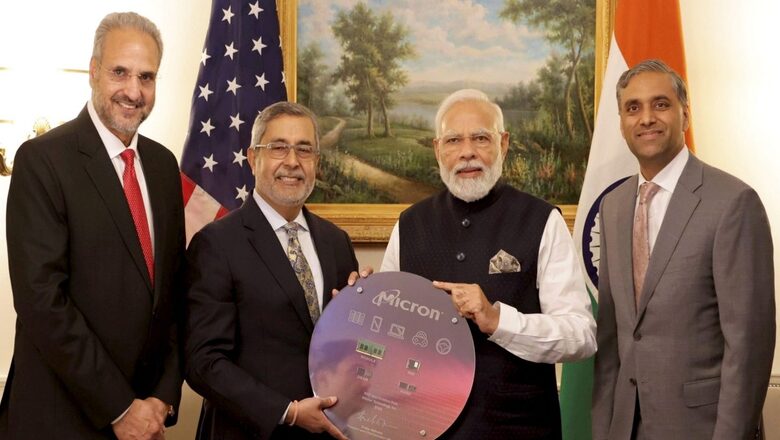
views
Micron’s $2.75 Billion Semiconductor Bet
US-based technology maker Micron decision to invest up to $825 million into India in two phases with a total investment of $2.75 billion, including government incentives under the PLI scheme worth $1.34 billion, for an assembly and testing facility at Sanand in Gujarat, is a big milestone in India’s roadmap and growth as a semiconductor nation. In the last 18 months, after the announcement of the semiconductor roadmap by Prime Minister Narendra Modi and the planned investment of Rs 76,000 crore to catalyse and build India’s semiconductor ecosystem, much progress has been made in a short period of time. The move also marks the first approval under the government’s $10-billion plus incentive plan to encourage chip manufacturing in India.
The Congress attempted to do so in the 1980s but was not successful. In fact, the party has been criticising the Micron deal and behaving like the proverbial sore loser, but that is hardly surprising. The party tried — in the 80s, 90s, and 2010 — but failed all three times to bring the semiconductor industry to India. No wonder Congress leaders have been peddling falsehoods about the Micron deal. This is just the beginning as there is more to come as India is rapidly growing as a significant and trusted partner in the global electronics and semiconductor value and supply chain systems, given how China is increasingly being isolated by the Biden administration.
Idaho-headquartered Micron, in the first phase, will start manufacturing in the 500,000 sq ft plant later this year. The facility will be used for the assembly and testing of DRAM and NAND flash modules; the project will create 5000 direct and 15,000 indirect community jobs and address demand from domestic and international markets. Micron will ramp capacity gradually over time in line with global demand trends. It will receive 50 percent fiscal support for the total project cost from the Indian government and incentives representing 20 percent of the total project cost from the state of Gujarat. The combined investment by Micron and the two government entities over the course of both phases will be up to $2.75 billion.
Modi government’s support will help fund the project and facilitate access to essential semiconductor infrastructure and resources to drive innovation and enhance local talent development within India. This is a win-win deal for both India and Micron. Micron’s plans are part of the company’s larger strategy to meet the expected long-term demand for memory and storage across markets and complement the company’s global assembly and test networks. The American chip maker’s investment to set up assembly and test manufacturing in India will fundamentally transform India’s semiconductor landscape and generate tens of thousands of high-tech and construction jobs. This investment will be a crucial building block in India’s blossoming semiconductor ecosystem. Micron has said that it selected Gujarat due to its manufacturing infrastructure, conducive business environment and a well-established talent pipeline in the Sanand Industrial Park (Gujarat Industrial Development Corporation – GIDC), in a glowing vindication of PM Modi’s famously progressive Gujarat model.
Micron’s new facility will focus on transforming wafers into ball grid array (BGA) integrated circuit packages, memory modules and solid-state drives. The US chipmaker will build and operate the assembly and test facilities in accordance with the company’s sustainability goals and in line with local and global environmental commitments. Micron is committed to designing and building the facility to meet or exceed leadership in energy and environmental design (LEED) gold standards. Additionally, the facility will use advanced water-saving technologies to enable zero liquid discharge.
During Prime Minister Modi’s historic US visit in June 2023, partnerships on 35 emerging technologies, including semiconductors, space, quantum computing, and AI, among others, were signed. Jet engine manufacturing in India by Hindustan Aeronautics Limited (HAL) is the most significant milestone. In a major announcement coinciding with PM Modi’s US visit, GE Aerospace too announced that it has signed an MoU with HAL to produce fighter jet engines for the Indian Air Force (IAF). These state-of-the-art jet engines, known for their endurance and durability, will enhance the capacity of the IAF. India tried in vain for 40 years under successive Congress regimes to develop the semiconductor industry but this is the first time a major semiconductor player — Micron — is coming to the country, thanks to the vision of PM Modi.
Micron’s plant in India will be ready by late 2024. China in May this year said Micron had failed a security review and barred operators of key domestic Chinese infrastructure from purchasing products from the United States’ biggest memory chipmaker, angering the Biden administration. The US Commerce Department declined to comment but export controls levied in October 2022 against China by the Biden regime clearly show that all is not well between the US and China. Both the Americans and the Chinese are engaged in a bitter confrontation but the US clearly has an upper hand given China’s lack of any major innovation in the semiconductor space. In fact, the investment by Micron into India couldn’t have come at a better time.
Semiconductor manufacturing is a very complex and technology-intensive sector with huge capital investments, high risk, long gestation and payback periods, and rapid changes in technology which require significant and sustained investments. India’s past efforts under the Congress regime did not succeed due to the unwillingness to recognise the complexities involved. Earlier attempts were made to directly set up fabs in the absence of a comprehensive programme. Under the leadership of Prime Minister Modi, however, a comprehensive semiconductor program has been formulated to provide a uniform incentive of 50 percent to support design, manufacturing and packaging. This program also supports R&D, talent and capacity building.
Outsourced semiconductor assembly and test (OSAT), which is also referred to as assembly, testing, marking, and packaging (ATMP) units, is the next step in the semiconductor value chain after semiconductor fabrication. Investing in advanced ATMP capabilities after having a reasonable scale of electronics system design and manufacturing (ESDM) is a natural progression towards accelerating the government’s efforts to set up semiconductor fabs in India.
Success in Semiconductor products require
- Design competency
- Access to technology
- Low cost of manufacturing and assured off-take
- Financial muscle to sustain down cycle
Setting up an ATMP facility by Micron is therefore a big milestone and will mark India’s global presence in the semiconductor industry. It will integrate India with the global supply chains, and also help in vertically integrating back into fabs. Micron will bring its existing mature stable supply chains to India or they may be substituted with some domestic equivalent when it reaches the required threshold quality and the standard levels that are necessary.
Don’t forget, Micron is an ‘integrated device manufacturer (IDM)’ which reduces risks associated with the project significantly. The success of the first few facilities will go a long way in catalysing India’s semiconductor ecosystem.
Modi government has approved Micron’s proposal to invest Rs 22,516 crore with fiscal support of 50 percent of the actual capital expenditure subject to a ceiling of Rs 11,258 crore. Micron will use its latest technologies, such as wire bonding, post-fab wafer finish and direct chip attach for manufacturing DDR4/5/6, SDRAM packages and memory modules, NAND Flash and SSDs. For semiconductor facilities like fab/packaging, technology changes every year and requires new investments, which Micron will bring of their own volition, to remain relevant in the sector.
In the absence of the required ecosystem of speciality chemicals/gasses/materials, equipment support etc, the first set of companies usually face disadvantages; therefore they need more support to offset the cost of bringing in the required ecosystem, including supply chain partners. Hence, the Congress rabble-rousers including the likes of Jairam Ramesh who have been calling the Micron deal a “sell-out” by India need to educate themselves before opposing the deal, only for the sake of stirring political noise. The investment will create 20,000 direct and indirect job opportunities in 5 years, besides creating a massive ecosystem which will help in generating several lakh jobs going forward and make India a hub for sourcing skilled manpower.
Currently, India imports memory products worth $11 billion annually. Therefore, it is important to become Atmanirbhar in this critical strategic sector. The “Project Pioneer” will reduce dependence on imports and also lead to exports. Micron’s products are used in mobiles, laptops, tablets, servers, automobiles, refrigerators, toasters, communications, consumer electronics, etc. The presence of a global semiconductor company like Micron will therefore give confidence to other global semiconductor companies of India’s readiness. Despite having established semiconductor ecosystems, countries like the US, EU, Japan, Korea and China are providing significant incentives to attract investments. Thus, higher incentive is required by India to attract investment from global players and therefore, the Micron deal by the Modi government will be a game changer for India’s semiconductor foray on a global scale.
Modi government is also planning inter-governmental talks to seek commitments from other nations to procure made-in-India semiconductor chips. This move comes even as the government is looking to secure consumers for India-fabricated semiconductor chips. The plan is to talk to developing countries which have more demand for “legacy node” semiconductor chips which also cost less to manufacture. Noting that demand in the semiconductor industry is cyclical, a new entrant to the supply side will have to offer some attractive terms to buyers and that is precisely what the government is doing. To receive government approval to set up a semiconductor fabrication in India, companies should either own a fabrication unit for semiconductor chips in the 65-28 nanometre range or possess the “production-grade licensed technologies” to make 28nm chips. They must also provide visibility into advanced node technologies through licensing or development.
The Indian Semiconductor Manufacturing Corporation (ISMC) announced an investment of Rs 22,900 crore ($3 billion) in a 65nm Analog Semiconductor Fabrication plant in Karnataka. In December 2021, the IT Ministry had unveiled the semiconductor fabrication incentive plan as a part of which the Modi government would make large, upfront investments, with 50 percent fiscal support, to back the semiconductor wafer fab proposals by various corporate entities. In some cases, the governmental capital support could scale 70 percent after including the SOPs by the states as well, making it a one-of-kind push by the government to seed a semiconductor-friendly ecosystem in India. Last year, the IT Ministry had revised the terms of the semiconductor manufacturing programme to offer a flat 50 percent incentive to all applicants, irrespective of the investment or the size of the chip they planned to manufacture.
The Foxconn Controversy
Let us now look at the Foxconn controversy, yet again a manufactured controversy with no credibility, by a discredited Rahul Gandhi and an equally tainted Congress party. First, let it be known that both Foxconn and Vedanta are committed to India’s semiconductor mission and the Make In India program, but have parted ways for their own internal reasons. It is quite normal for potential business partners to part ways, this happens all the time across geographies. Their decision to work in India with other local and global partners means they continue to be serious about their India plans. Bringing national champions into global electronics value chains is a key policy objective of PM Modi’s visionary production linked incentive (PLI) scheme.
For instance, the news about the Tata Group getting one step closer to manufacturing the iconic iPhone for global markets is a very positive development and will help grow the Indian EMS and supply chain/component ecosystem. The withdrawal of Foxconn from its JV with Vedanta changes nothing about India’s semiconductor goals. It allows both companies to independently pursue their strategies for Indian semiconductors and electronics. Foxconn had said that it is confident about the direction of India’s semiconductor development.
All the huffing and puffing by those in the Congress, who did nothing about India’s electronics and semiconductor capabilities whilst players from other countries grew in these last three decades, should not be lecturing the Modi government. Tremendous progress has been made in electronics manufacturing in the last nine years and rapid progress in the semiconductor space in the last 18 months under PM Modi’s aegis. In fact, both Foxconn and Vedanta have independently declared their commitment to India’s semiconductor program, but they will do so with other partners.
Foxconn has announced that they are preparing to apply for Silicon Fab and Display Fab. Similarly, Vedanta has also committed to reapplying with new partners. Foxconn is also in talks with Taiwan’s TSMC and Japan’s TMH group for technology and joint venture partnership to start semiconductor fabrication units in India.
Besides, other major semiconductor companies are seriously evaluating India as a semiconductor design and manufacturing hub. This is bad news for the Congress, which actively attempts to scuttle any new initiative India takes. It is now worried that India’s rise as a semiconductor manufacturing hub will further consolidate its position in the world as a credible player in the technology domain. Why does the Congress loathe a confident and self-reliant India?
Foxconn is the largest assembler of Apple iPhones in India. In FY23, out of $11bn worth of smartphone exports from India, exports by Apple alone were over $5bn, in which Foxconn, as the assembler for iPhones, played a key role. Overall electronics exports from India in FY23 were up 49 percent over FY22, at a record $25.3bn, underlining the resounding success of the Modi government’s PLI scheme. Under the Congress regime, the above number was not even $2.5bn.
Tata Group, India’s largest conglomerate, is close to an agreement to acquire Wistron’s Karnataka-based factory in August, marking it the first time a local company would move into the assembly of iPhones, according to people familiar with the matter. An Indian company making iPhones will prove to be a significant boost for PM Modi’s efforts to challenge China’s status as the factory of the world. In fact, China’s status on this count has already started receding.
Companies making and selling high-end devices, such as iPhone from the Apple stable and the Galaxy S and Note Series by Samsung, are among the big beneficiaries of the PLI scheme, as are some homegrown players like Lava, Karbonn, Micromax and Intex. With the demand for electronics hardware expected to rise rapidly to over $400 billion by 2025, India cannot afford to bear foreign exchange outgo on account of electronics imports. The decision by the likes of Apple, Foxconn and Micron to either expand or establish their India presence, therefore, could not have come at a better time. Make In India, based on access to market, capital and technology, is not just a slogan but a work ethic that is rapidly transforming India’s industrial landscape, driven among other things, by Prime Minister Narendra Modi’s unrelenting global outreach.
The author is an Economist, National Spokesperson for BJP and Bestselling Author of “The Modi Gambit”. Views expressed in the above piece are personal and solely that of the author. They do not necessarily reflect News18’s views.



















Comments
0 comment